When you buy through our links, we may earn a commission. Products or services may be offered by an affiliated entity. Learn more.
When you spend money on a new mattress, it’s natural to expect many years of sound sleep in return for your investment. Luckily, there are many reasonably priced models that tend to have a long lifespan as long as users properly care for them. Knowing what to look for can help you discern between good-quality builds versus mattresses made with cheap materials that might break down sooner.
- Rigorous durability testing led us to our top pick, the Helix Midnight Luxe. Its high-quality foam layers & sturdy coils hedge against sagging while maximizing comfort & support.
- Durability is important, but it’s not the end-all, be-all. Make sure to account for individual factors, like sleeping position, weight, and firmness preferences, when choosing a mattress.
- If you’re ready to get to the reviews, catch up quickly with our 1-minute videos.
Our Top Picks
-
Best Mattress Overall – Helix Midnight Luxe
View Details
-
Best Luxury Mattress – Saatva HD
View Details
-
Best Mattress for Back Pain – WinkBed Plus
View Details
-
Best Mattress for Side Sleepers – Nolah Evolution 15
View Details
-
Best Mattress for Heavy Sleepers – Titan Plus Core
View Details
-
Best Mattress for Couples – Bear Elite Hybrid
View Details
Swipe for more
Best Mattress Overall
Helix Midnight Luxe
9.7 /10
Test Lab Score
25% off sitewide
25% off sitewide
The Helix Midnight Luxe balances the pressure-relieving qualities of memory foam with the long-lasting support of a hybrid. Thanks to stronger coils along the sides, the mattress edges hold up well under pressure and should stand the test of time. Additional benefits include strong temperature regulation and decent ease of movement.
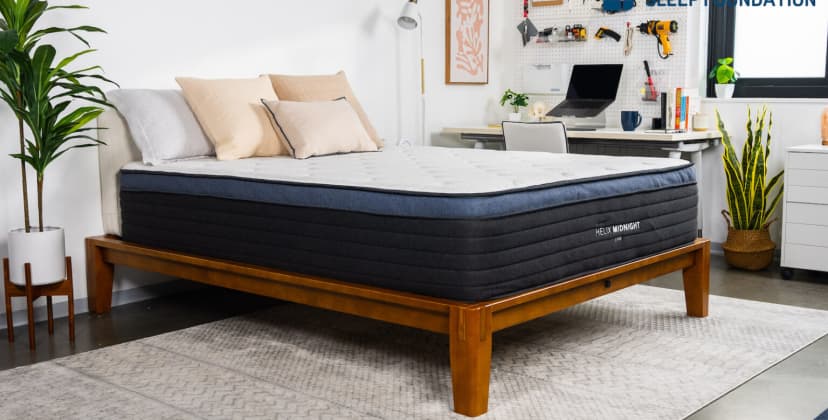
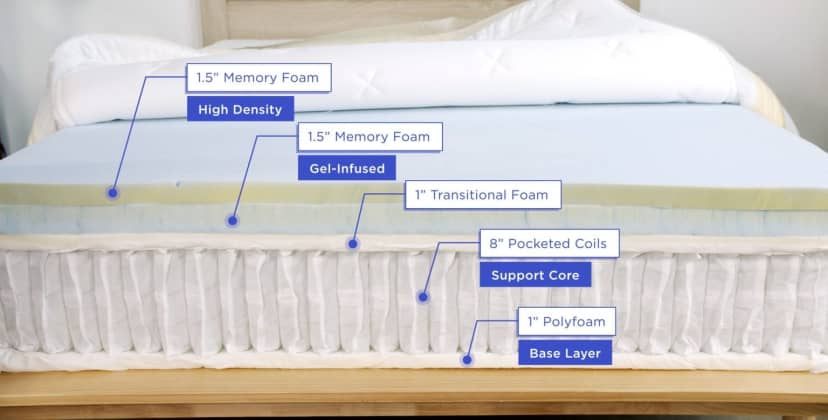

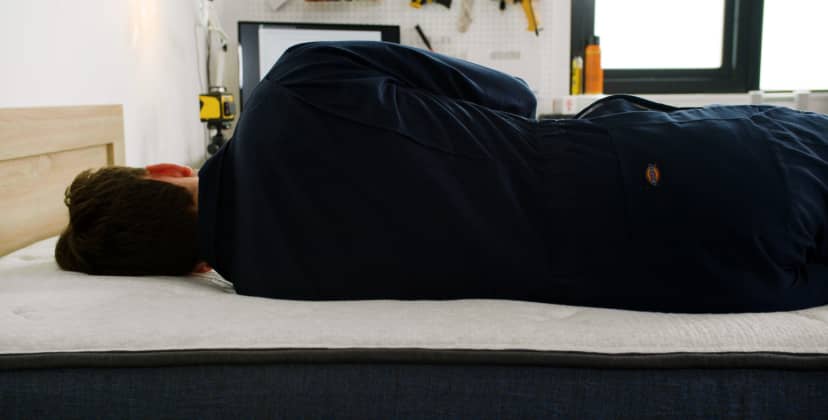
Credit: Sleep Foundation Test Lab
Price
$1,799
Mattress Type
Hybrid
Firmness Options
Medium Firm (6)
Trial Period
120 nights (30-night requirement)
At a Glance
- Who It’s Best For: Side sleepers and back sleepers.
- Feel: Medium firm (6) with notable pressure relief and strategic support.
- What It’s Made Of: Breathable Tencel cover, followed by two comfort layers of memory foam. Transitional polyfoam, zoned pocketed coils with a reinforced perimeter, and a high-density foam base.
- What We Don’t Like: Stomach sleepers may find they sink in too far.
Scoring & Reviews
The following ratings show how suitable this mattress is for different sleeping positions and sleeper weights. These scores are determined by how well the mattress supports and relieves pressure for each sleeper type.
We performed a meta-analysis on 5876 validated customer reviews of the Helix Midnight Luxe. This is what people who bought the mattress had to say:- Comfort and Support: Many reviewers express that the mattress provides exceptional comfort and support, especially noting its ability to alleviate back, hip, and shoulder pain.
- Sleep Quality Improvement: The mattress is frequently described as transformative for those who previously struggled with sleep disturbances.
- Temperature Regulation: Positive remarks are made about the cooling properties of the mattress. Users find the cooling aspect effective, helping to maintain a comfortable sleeping temperature throughout the night.
- Customer Service: Experiences with customer service are predominantly positive, with buyers appreciating the responsive and helpful nature of the support team. Issues are resolved satisfactorily, contributing to a positive overall customer experience.
- Durability Concerns: A few reviewers express concerns about the mattress showing signs of wear or sagging prematurely. These concerns are not widespread but are significant enough to be noted by potential buyers.
- Mixed Reviews on Firmness: While many find the mattress perfectly balanced, there are mixed reviews regarding its firmness. Some users find it softer than expected given its firmness level. While the ‘medium firm’ rating is appropriate by our measurements, the bed does have a ‘cushy’ foam feel that makes for a fairly soft surface feel.
Full Details
Construction Breakdown
The mattress starts with two memory foam comfort layers, followed by a transitional polyfoam layer. The support core consists of individually pocketed coils that are zoned to create extra pushback beneath your midsection and reinforced around the perimeter.
A high-density foam base completes the hybrid design. A moisture-wicking Tencel cover fully encases the mattress for a sleek finish. For an additional fee, you can upgrade to a cover made of proprietary GlacioTex cooling fabric.
Trial, Shipping, and Warranty
Free shipping in the contiguous U.S. and two pillows at no extra cost. Your purchase includes a 120-night sleep trial, and if you decide to keep the mattress, you’ll also receive a lifetime warranty against premature sagging and other structural defects.
Best Value Mattress
Brooklyn Bedding CopperFlex Hybrid
8.1 /10
Test Lab Score
30% off sitewide
30% off sitewide
If you’re shopping with a limited budget, the Brooklyn Bedding CopperFlex Hybrid offers great bang for your buck. A complex six-layer design with copper-infused foam, zoning to support your midsection, and sturdy coils ensure a comfy balance of cushioning, cooling, support, and bounce – but the sticker price is well below average for a hybrid model.

Credit: Sleep Foundation Test Lab
Price
$699
Mattress Type
Hybrid
Firmness Options
Medium Firm (6)
Trial Period
120 nights (30-night requirement)
At a Glance
- Who It’s Best For: Hot sleepers who weigh up to 230 pounds and primarily sleep on their side and/or back.
- Feel: Balanced medium firm (6) feel with deep cushioning on the surface, zoned support from the transitional foam, and a steady coil bounce.
- What It’s Made Of: Polyfoam and memory foam comfort layers, followed by multi-zone transitional foam and pocketed coils with perimeter reinforcement
- What We Don’t Like: Sleepers over 230 pounds may sink too deeply into the foam layers.
Scoring & Reviews
The following ratings show how suitable this mattress is for different sleeping positions and sleeper weights. These scores are determined by how well the mattress supports and relieves pressure for each sleeper type.
We performed a meta-analysis on 549 validated customer reviews of the Brooklyn Bedding CopperFlex Hybrid. This is what people who bought the mattress had to say:- Pricing and Value: Many reviewers have noted the mattress is affordablly priced given its quality and craftsmanship, making it an excellent option for shoppers following a budget.
- Heat Regulation: Several users say the mattress retains little to no heat, resulting in a comfortable night’s sleep for people who tend to run warm in bed.
- Edge Support: Users report the mattress has great edge support, pointing to the sturdy coil support system and reinforced perimeter.
- Odor and Off-Gassing: Some reviews mention that the mattress emits some off-gassing odor after being unboxed, which is common for new mattresses with foam layers. The smell will eventually dissipate.
- Foam Option: Shoppers appreciate the all-foam CopperFlex, allowing them to choose between two distinct types based on what they need most as a sleeper.
- Customer Service: Positive feedback about Brooklyn Beddng’s customer service team indicate the company is helpful and responsive when issues arise.
Full Details
Construction Breakdown
The CopperFlex Hybrid’s comfort system consists of adaptive polyfoam and copper-infused memory foam layers encased in a Euro-top cover. A third memory foam layer provides additional cushioning. The transitional foam layer is divided into three zones to ensure extra pushback around your torso and hips, as these areas tend to sink more than the rest of the body.
Pocketed coils and high-density base foam make up the support core. Coils running the length of the mattress on each side are reinforced to protect the edges and help you get in and out of bed more easily. At 12 inches thick, the CopperFlex Hybrid is compatible with standard-pocket sheets.
Trial, Shipping, and Warranty
Brooklyn Bedding offers free ground shipping to shoppers in the contiguous U.S. Your order includes a 120-night sleep trial, during which you can test out the CopperFlex Hybrid in your own bedroom and decide whether it’s right for you. All purchases are also covered under lifetime warranties.
For even more savings, Brooklyn Bedding offers a 5% discount to teachers, students, military personnel, first responders, and medical providers.
Best Luxury Mattress
Saatva HD
9.2 /10
Test Lab Score
$300 off orders of $1,000 or more
$300 off orders of $1,000 or more
The Saatva HD combines an assortment of top-quality components to deliver a no-sag sleep experience for people weighing up to 500 pounds. Sturdy layers of latex, high-density foams, and robust steel coils form a reliable cradle that helps keep the spine on an even plane. This mattress also boasts strong edge support, temperature control, stellar ease of movement, and surprisingly decent motion isolation.
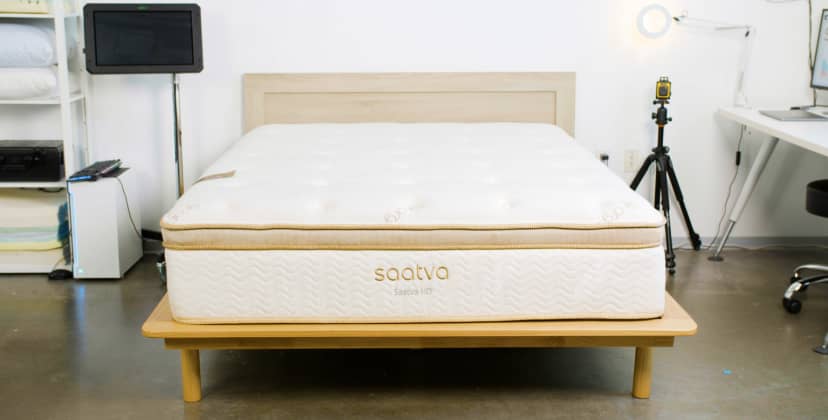


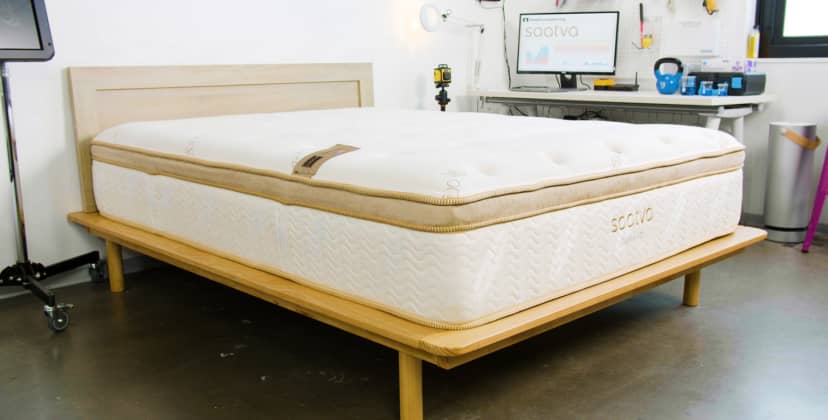
Credit: Sleep Foundation Test Lab
Price
$2,945
Mattress Type
Innerspring
Firmness Options
Firm (7)
Trial Period
365 Nights ($99 Return Fee)
At a Glance
- Who It’s Best For: Back and side sleepers.
- Feel: Firm (7), but people over 230 pounds will settle into the top layers and have a slightly softer overall impression.
- What It’s Made Of: Hand-tufted Euro-top cover with 3 inches of quilting, followed by a layer of zoned latex. The rest of the comfort system includes high-density memory foam, polyfoam, and Saatva’s spinal wire. The sturdy support core features thick, 12-gauge tempered steel offset coils encased in a high-density polyfoam encasement.
- What We Don’t Like: Expensive. Return fee of $149. Incompatible with many foundations or adjustable bases. Requires deep-pocket sheets.
Scoring & Reviews
The following ratings show how suitable this mattress is for different sleeping positions and sleeper weights. These scores are determined by how well the mattress supports and relieves pressure for each sleeper type.
We performed a meta-analysis on 133 validated customer reviews of the Saatva HD. This is what people who bought the mattress had to say:- Quality of Materials: Users frequently comment on the high-quality materials and construction of the mattress, noting its durability and the luxurious feel of the fabrics used.
- Positive Impact: Several reviewers mention significant improvements in sleep quality and reductions in back and joint pain since switching to this mattress.
- Customer Service: The customer service provided by Saatva receives high marks for being helpful, responsive, and accommodating, enhancing the overall purchasing experience.
- Delivery and Setup: The delivery and setup process is often described as efficient and professional, with many appreciating the white glove delivery service that includes setup and old mattress removal.
- Price and Value: Reviewers feel that the mattress represents good value for money, considering its quality and the level of service provided.
- Heavy and Bulky: Some users find the mattress to be quite heavy and difficult to move or adjust, which can make changing sheets or moving the mattress challenging.
Full Details
Construction Breakdown
The Saatva HD has a breathable organic cotton cover certified by the Global Organic Textile Standard (GOTS). Quilted polyfoam adds extra padding with an integrated, hand-tufted Euro-top design. The comfort system also includes five-zone natural Talalay latex and memory foam. These layers contour to the sleeper and provide additional support to the lumbar area to help prevent pressure buildup.
The support core consists of a layer of thick 12.5-gauge innerspring coils. The coils feature a polyfoam encasement around the perimeter, allowing more usable surface area for sleepers. The layer also has a spinal zone wire for additional lumbar support.
Trial, Shipping, and Warranty
Like Saatva’s other mattresses, the HD is delivered with complimentary White Glove delivery and old mattress removal. Saatva offers a lifetime warranty and a 365-night sleep trial, with a $149 return fee to cover handling costs.
Most Comfortable Mattress
Leesa Sapira Chill Hybrid
9.0 /10
Test Lab Score
25% off sitewide
25% off sitewide
The Leesa Sapira Chill Hybrid delivers a winning combo of plush, adaptive foam layers and zoned coils to ensure a comfy balance of cushioning, targeted support, and responsiveness to movement. You can choose from three firmness levels based on your body weight and preferred sleep position.

Credit: Sleep Foundation Test Lab
Price
$1,698
Mattress Type
Hybrid
Firmness Options
Medium (5), Medium Firm (6), Firm (7)
Trial Period
120 nights (30-night requirement)
At a Glance
- Who It’s Best For: Side and back sleepers between 130 and 230 pounds, couples, hot sleepers, and people with frequent or chronic back pain.
- Feel: Available in medium (5), medium firm (6), and firm (7) designs.
- What It’s Made Of: A Euro-top encasing four individual foam layers, followed by three-zone pocketed coils with perimeter reinforcement and high-density base foam.
- What We Don’t Like: Off-gassing odor can be strong for the first few nights, and the high-profile design means you’ll need to use a deep-pocket fitted sheet,
Scoring & Reviews
The following ratings show how suitable this mattress is for different sleeping positions and sleeper weights. These scores are determined by how well the mattress supports and relieves pressure for each sleeper type.
We performed a meta-analysis on 25 validated customer reviews of the Leesa Sapira Chill Hybrid. This is what people who bought the mattress had to say:- Suitability for Different Sleepers: Several reviews highlight that the mattress is suitable for side sleepers, stomach sleepers, and even for those who experience hip and shoulder pain.
- Temperature Regulation: Some reviews mention the mattress being cool and comfortable, while others complain about it sleeping hot, despite being the “Chill” version.
- Quality and Durability Concerns: A few reviewers express concerns about the mattress’s durability or mention receiving a damaged product.
- Overall Satisfaction: While many reviews are overwhelmingly positive, scoring 5 out of 5, there are a few lower scores where users mention issues like the mattress being too soft, too bouncy, or not meeting expectations in terms of firmness and comfort.
- Specific Needs: Some reviews from users with back pain or who have had long-term use of other mattresses indicate that this model significantly improved their sleep quality and comfort.
Full Details
Construction Breakdown
The Sapira Chill Hybrid’s comfort system begins with a 2-inch layer of gel-infused polyfoam sewn to the Euro-top cover. Additional comfort layers of memory foam and adaptive polyfoam add to the invitingly plush feel, and you’ll notice these materials molding to your figure as you settle into the mattress. Dense transitional foam pushes back against your weight and creates a barrier between your body and the support core.
Pocketed coils and high-density base foam provide excellent overall stability. The coils are divided into three zones with stronger springs resting beneath your torso and hips – this gives extra support to your midsection and prevents you from sinking too deeply into the mattress. A reinforced perimeter also minimizes compression along the edges when you get in and out of bed. At 14 inches thick, this is a high-profile mattress and you’ll need to invest in a fitted sheet with deep pockets.
Trial, Shipping, and Warranty
Leesa provides complimentary ground shipping to customers in all 50 states and select Canadian locations. The Sapira Chill Hybrid’s sleep trial spans 120 nights in length, with a mandatory 30-night break-in period before returns can be initiated. If you decide to keep the mattress, it’s further covered under a lifetime warranty against structural and material defects.
Best Mattress for Back Pain
WinkBed Plus
9.9 /10
Test Lab Score
30% off all WinkBeds mattresses
30% off all WinkBeds mattresses
Designed for sleepers who weigh 250 pounds or more, the WinkBed plus contains several features that support the curve of the lower back. This model swaps out the polyfoam found in the other WinkBed models and instead adds a layer of latex, known for its resistance to sagging. Along with being one of the most durable models we’ve tested, the WinkBed Plus also boasts best-in-class edge support, temperature control, and ease of movement.
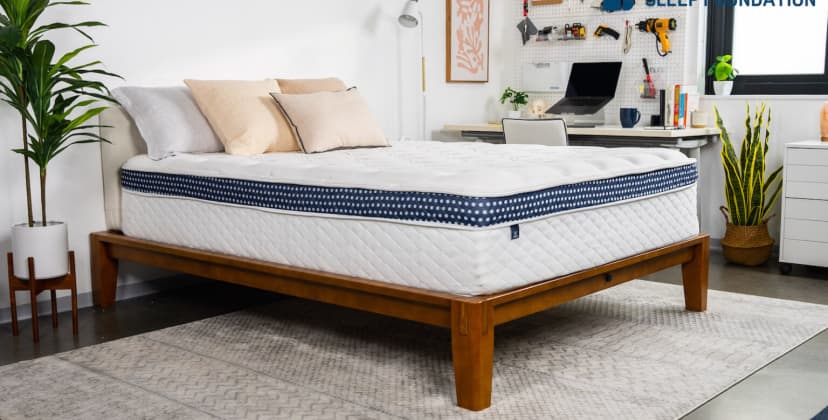
Credit: Sleep Foundation Test Lab
Price
$2,856
Mattress Type
Latex Hybrid
Firmness Options
Firm (8)
Trial Period
120 nights (30 night requirement)
At a Glance
- Who It’s Best For: Side, back, and stomach sleepers over 130 pounds.
- Feel: Firm (8), although heavier individuals will experience it subjectively softer. Keeps sleepers mostly “on” rather than “in” the bed.
- What It’s Made Of: Moisture-wicking Tencel cover quilted with high-density polyfoam. Includes 2.5 inches of latex with seven zones for targeted spinal support. Foam lumbar layer, and the support core contains 5-zone pocketed coils made of triple-tempered steel with a reinforced perimeter.
- What We Don’t Like: May need to buy deep-pocket sheets. May cause a little motion transfer.
Scoring & Reviews
The following ratings show how suitable this mattress is for different sleeping positions and sleeper weights. These scores are determined by how well the mattress supports and relieves pressure for each sleeper type.
We performed a meta-analysis on 8573 validated customer reviews of the Winkbed. This is what people who bought the mattress had to say:- Quality of Materials: The mattress is frequently described as well-made, with durable materials that contribute to a good night’s sleep.
- Cooling Features: Some reviewers mention that the mattress does a good job of regulating temperature, providing a cooler sleep experience.
- Edge Support: While generally satisfied with the support, a few reviewers note that edge support could be better.
- Comfort and Support: Many reviewers praise the mattress for its comfort and support, often mentioning relief from back pain and improved sleep quality.
- Firmness Options: Customers appreciate the variety of firmness options available, finding the right balance for their personal preferences.
- Value for Money: Many users feel the mattress is worth the investment, offering good value for the quality and comfort provided.
- Made in the USA: Buyers are pleased that the mattresses are made in the USA, supporting domestic manufacturing.
Full Details
Construction Breakdown
As a mattress designed for people who weigh more than 230 pounds, the WinkBed Plus begins with a top layer of high-density polyfoam and a second layer of zoned latex. Both of these materials are highly responsive, adding extra bounce to the surface and reinforcing the firm (8) feel. A Euro-top surface adds some plushness for comfort without sacrificing the Plus’s supportive qualities.
The support core contains 7.5-inch pocketed coils in a zoned arrangement. Thicker coils lie beneath the midsection to provide push-back and prevent sagging around the sleeper’s heaviest areas. The coils are also bolstered along the perimeter to reduce sinkage when you lie near or sit along the edges. A cover made of breathable, moisture-wicking Tencel fabric encases the mattress.
Trial, Shipping, and Warranty
WinkBeds offers free ground shipping throughout the contiguous U.S. Each order comes with a 120-night trial. If you find the Plus too firm, you may exchange the mattress for a model with a different firmness level at no extra charge. WinkBeds are backed by lifetime warranties.
Best Mattress for Side Sleepers
Nolah Evolution 15
9.2 /10
Test Lab Score
35% off sitewide + extra $100 off with code: SF100
35% off sitewide + extra $100 off with code: SF100
The Nolah Evolution 15 features hole-punched foams and robust coils under the hips and shoulders intended to eliminate the pressure points that often occur when side sleeping. This mattress is offered in three firmness options, which vary slightly in performance but generally offer good motion isolation, temperature neutrality, and ease of movement. Many shoppers over 230 pounds have noted that the bed is more supportive than competing models.

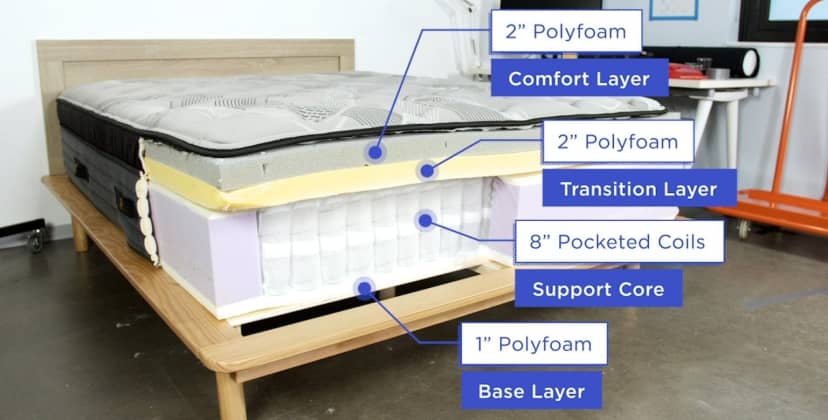
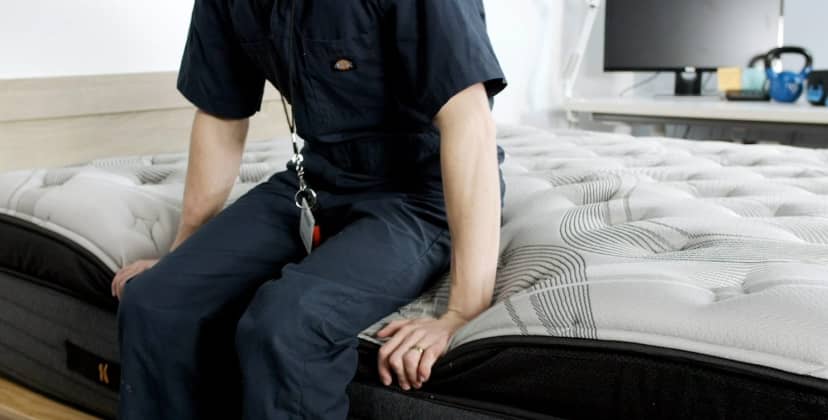
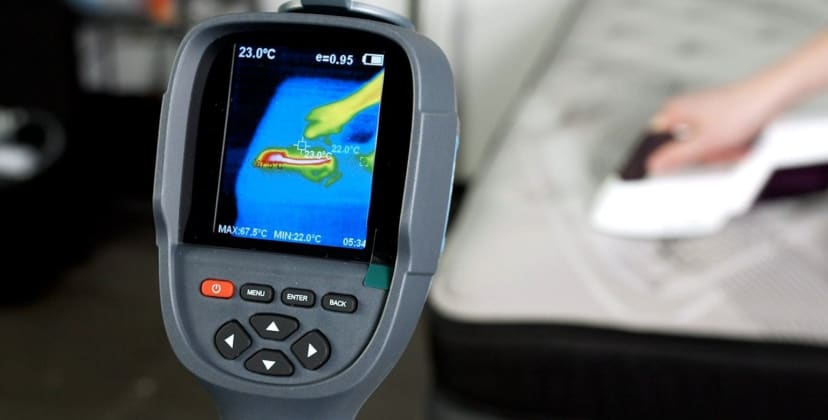
Credit: Sleep Foundation Test Lab
Price
$1,624
Mattress Type
Hybrid
Firmness Options
Medium (5), Medium Firm (6), Firm (8)
Trial Period
120 nights (30-night requirement), $99 return pickup fee
At a Glance
- Who It’s Best For: Side sleepers. People over 230 pounds gravitate toward the medium firm (6) bed. Firm (8) option for back and stomach sleepers.
- Feel: Medium (5), medium firm (6), and firm (8) options. Feels like a foam mattress, offering close contouring and the feeling of sleeping “in” the bed — albeit with the firm structure to prevent sagging.
- What It’s Made Of: Organic cotton cover with cooling fibers. Thick Euro-top style comfort system with 2 inches of polyfoam, an inch of zoned polyfoam, another 2 inches of slightly firmer polyfoam, and a final inch of transitional polyfoam. The support core consists of pocketed coils, followed by a thin layer of polyfoam.
- What We Don’t Like: Requires deep-pocket sheets. Return fee of $99.
Scoring & Reviews
The following ratings show how suitable this mattress is for different sleeping positions and sleeper weights. These scores are determined by how well the mattress supports and relieves pressure for each sleeper type.
We performed a meta-analysis on 897 validated customer reviews of the Nolah Evolution 15. This is what people who bought the mattress had to say:- Motion Isolation: Couples note the excellent motion isolation, which minimizes disruptions from partner movements during the night.
- Edge Support: The edge support of the mattress is frequently highlighted, with many finding it adequate for sitting or sleeping near the edge without feeling like they will roll off.
- Softness: Many reviewers discuss the softness of the mattress. Some find it too soft, causing discomfort, especially for heavier individuals, while others appreciate the plushness.
- Pressure Relief and Support: Reviewers frequently highlight relief from back and shoulder pain, attributing this to the supportive foam layers and zoned coil system.
- Heat Retention: A few reviewers note that the mattress retains heat, making it uncomfortable for some, particularly in warmer climates or for those who sleep hot.
- Durability and Quality: Users often comment on the high quality and durability of the mattress, noting that it maintains its shape and comfort over time.
Full Details
Construction Breakdown
The Evolution 15’s comfort system features a Euro-top containing four individual foam layers. Each layer is progressively denser from top to bottom, so you’ll notice some plushness when you get into bed and a cradling feel as your body settles. All four foams have an open-cell composition, so bothersome heat retention shouldn’t be a major issue. A graphite gel infusion in the second layer delivers additional cooling.
The support core consists of pocketed coils in a zoned arrangement. Thicker coils push back against the extra weight in your chest, stomach, and hips, while thinner coils create a gentler feel for lighter areas of your body. Extra perimeter reinforcement also means the mattress won’t sag when you lie or sit along the edges. The Evolution 15’s cover is made of organic cotton woven with cooling ArcticTex fabric.
Trial, Shipping, and Warranty
Nolah offers free ground shipping throughout the contiguous U.S. The Evolution 15 comes with a 120-night sleep trial, but you can opt out of the trial and cut your up-front costs by as much as $150. The standard manufacturer’s warranty covers structural defects for as long as you retain original ownership. You may purchase additional coverage for stains and spills for 10 years.
Best Mattress for Heavy Sleepers
Titan Plus Core
8.4 /10
Test Lab Score
30% off sitewide
30% off sitewide
For the Titan Plus Core, Brooklyn Bedding uses firmer foams that stand up better to repeated weight application. The result is a bed with powerful performance for sleepers weighing 250 to 500 pounds. The Titan Plus Core also boasts a breathable sleep surface and strong edges that enable sleepers to spread out across the bed without fears of roll-off.
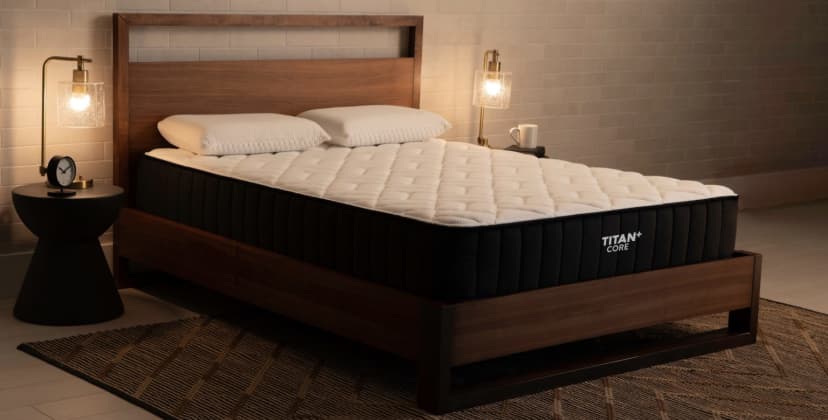
Price
$1,049
Mattress Type
Hybrid
Firmness Options
Firm (8)
Trial Period
120 nights (30-night requirement)
At a Glance
- Who It’s Best For: Side, back, and stomach sleepers over 130 pounds.
- Feel: Firm (8) surface that allows minimal sinkage.
- What It’s Made Of: Quilted cover with an inch of cooling, gel-infused foam and 2 inches of transitional polyfoam. A 13.5-gauge pocketed coil support core with firm base polyfoam.
- What We Don’t Like: May feel too firm for those under 130 pounds. May transfer some motion. Return fee of $99.
Scoring Breakdown
The following ratings show how suitable this mattress is for different sleeping positions and sleeper weights. These scores are determined by how well the mattress supports and relieves pressure for each sleeper type.
We performed a meta-analysis on 2753 validated customer reviews of the Titan Plus. This is what people who bought the mattress had to say:- Firmness Level: The Titan Plus is exceptionally firm – some users appreciate this quality, others say the mattress doesn’t provide enough cushioning.
- Supportive for Plus Size: The mattress was originally designed for plus-size people, and many users who fall into this category enjoy the extra reinforcement and pushback.
- Edge Support Issues: Users are generally satisfied with the mattress’s edge support, with most saying they can sit or sleep along the perimeter without feeling like they’re going to roll out of bed.
- Motion Transfer: Some owners who sleep with a partner report strong motion transfer and, in some case, sleep disruptions resulting from movement.
- Odor: Users say the foam layers emit off-gassing smell for the first 24 to 48 hours, but little to no odor after that.
- Positive Customer Service Experiences: Many highlight Brooklyn Bedding’s convenient, mattress-in-a-box delivery system and hassle-free trial period.
Full Details
Construction Breakdown
The Titan Plus Core is one of the firmest hybrid models we’ve tested firsthand. Rating as an 8 on our 10-point firmness scale, the mattress feels exceptionally supportive and maintains a flat, even surface for most people – even those weighing more than 230 pounds.
A thin layer of memory foam is quilted into the cover, followed by 2 inches of dense polyfoam. These materials provide light cushioning. The support core consists of thick pocketed coils over a base layer of high-density polyfoam.
We found that the Titan Plus Core sleeps reasonably cool. If you are a hot sleeper, you can opt to include a phase change material (PCM) panel sewn into the cover. PCM is engineered to capture and release body heat on contact, creating a surface that feels cool at all times. Measuring 12 inches thick, the Titan Plus Core is considered a medium-profile mattress.
Trial, Shipping, and Warranty
Shipping is free throughout the contiguous U.S. Your purchase comes with a 120-night sleep trial, and you’ll also receive a lifetime manufacturer’s warranty if you decide to keep the mattress.
Best Mattress for Couples
Bear Elite Hybrid
8.5 /10
Test Lab Score
40% sitewide with code: SF40
40% sitewide with code: SF40
The Bear Elite Hybrid is designed for even weight distribution to prevent pressure buildup and excessive wear-and-tear. Although it contains memory foam, the Bear Elite Hybrid responds quickly to pressure and shouldn’t cause sleepers to feel stuck in the bed. Of the three firmness options, the firm model provides the best edge support.
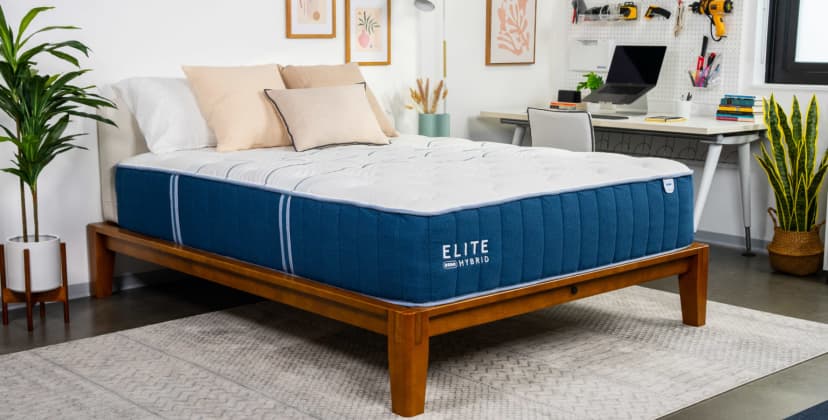
Credit: Sleep Foundation Test Lab
Price
$1,499
Mattress Type
Hybrid
Firmness Options
Medium (5), Medium Firm (6), Firm (8)
Trial Period
120 nights (30-night break-in period)
At a Glance
- Who It’s Best For: Side and back sleepers of most weight groups, depending on firmness level.
- Feel: Medium (5), medium firm (6), and firm (8) models. Plush pressure relief (medium and medium firm). Easier movement and less of a close hug (firm).
- What It’s Made Of: Hand-quilted cover with cooling phase change material. Next is a layer of copper-infused memory foam over a more resilient layer of transition foam. The support section contains individually wrapped coils, which are reinforced around the perimeter and zoned into five sections. Has a final layer of base foam.
- What We Don’t Like: May require deep-pocket fitted sheets. May not work for stomach sleepers.
Scoring & Reviews
The following ratings show how suitable this mattress is for different sleeping positions and sleeper weights. These scores are determined by how well the mattress supports and relieves pressure for each sleeper type.
We performed a meta-analysis on 3703 validated customer reviews of the Bear Elite Hybrid. This is what people who bought the mattress had to say:- Comfort and Support: Many reviewers highlight the mattress’s balance of comfort and support, often mentioning relief from back pain and improved sleep quality.
- Firmness Options: Customers appreciate the various firmness options, with some opting for firmer versions after experiencing discomfort with medium firmness.
- Temperature Regulation: Several reviews note the mattress’s ability to stay cool, which enhances sleep quality, especially in hot weather.
- Size and Upgrade Options: Customers are pleased with the availability of different sizes and the option to upgrade, which provides flexibility for different needs and preferences.
- Quality of Additional Products: Positive remarks on the quality of accompanying products like pillows and sheets, which are often included as free additions.
- Motion Isolation: Many reviewers highlight the mattress’s excellent motion isolation, making it ideal for shared sleeping arrangements.
Full Details
Construction Breakdown
The Elite Hybrid’s comfort system contains memory foam over transitional polyfoam. A cooling gel infusion in the top layer helps dissipate heat and keep you cool, while the transitional foam is divided into five firmness zones based on where most of your weight is concentrated.
This helps ensure pushback for the torso and hips, and a gentler feel beneath lighter areas of your body such as the head and legs. The support core consists of pocketed coils and high-density base foam. Thicker coils around the perimeter help strengthen the edges, allowing you and your partner to use the entire surface for sleep and sex.
A cover made with Celliant fabric encases the mattress. Celliant is engineered to capture and release heat on contact, maintaining a cool-to-the-touch feel at all times. You can choose from medium (5), medium firm (6), and firm (8) feels for your Elite Hybrid.
Trial, Shipping, and Warranty
Ground delivery is free throughout the contiguous U.S. Bear’s sleep trial spans 120 nights in length, and includes free shipping on returns. Those who keep their mattress receive a lifetime warranty covering various defects as long as they retain original ownership. An accidental protection plan against stains and other types of physical damage is available for an additional fee.
Best Temperature-Regulating Mattress
Birch Mattress
8.8 /10
Test Lab Score
25% off sitewide
25% off sitewide
Natural latex hybrid mattresses tend to be among the coolest, and the Birch Mattress is no exception. Breathable cotton, wool, latex, and coil layers ensure there is virtually no heat buildup overnight. Our testers also found the Birch Mattress offered notable bounce and excellent edge support, and the latex-coil combination is inherently resistant to sagging and body impressions.
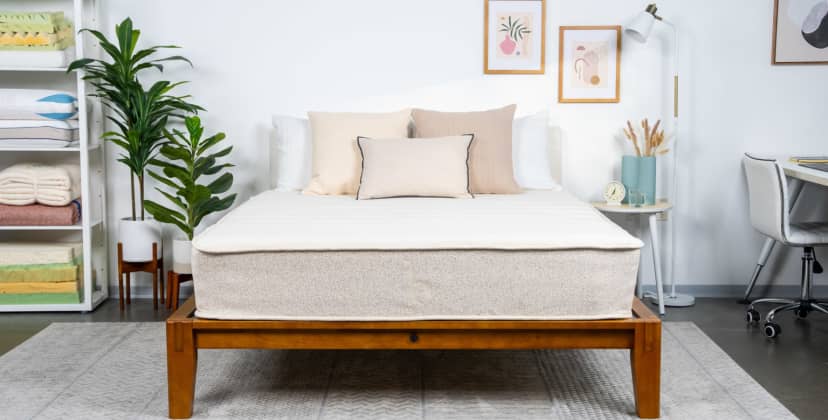
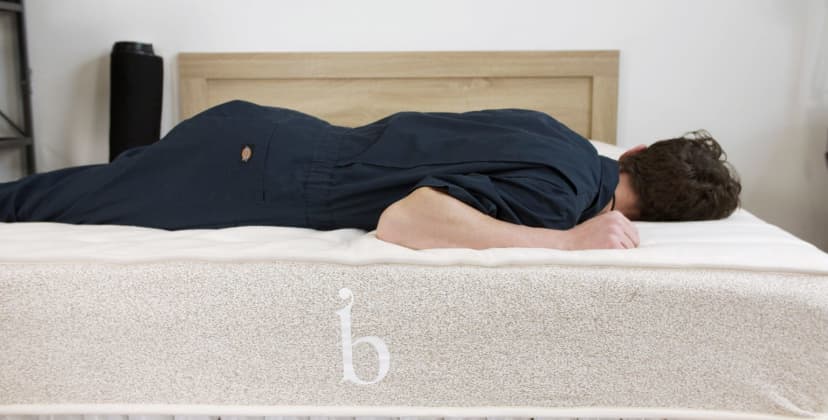


Credit: Sleep Foundation Test Lab
Price
$1,499
Mattress Type
Latex Hybrid
Firmness Options
Medium Firm (6)
Trial Period
120 nights (30-night requirement)
At a Glance
- Who It’s Best For: Back and stomach sleepers between 130 and 230 pounds.
- Feel: Medium firm (6). No body-hugging feel of memory foam, but it helps alleviate pressure points through moderate contouring and weight distribution.
- What It’s Made Of: GOTS-certified woven organic cotton cover plus two layers of organic wool. Comfort system is natural Talalay latex, and the support core is pocketed coils with reinforced sides and a wool base.
- What We Don’t Like: Too firm for people under 130 pounds. Not supportive enough for sleepers over 230 pounds. Motion transfer.
Scoring & Reviews
The following ratings show how suitable this mattress is for different sleeping positions and sleeper weights. These scores are determined by how well the mattress supports and relieves pressure for each sleeper type.
We performed a meta-analysis on 1917 validated customer reviews of the Birch Mattress. This is what people who bought the mattress had to say:- Comfort and Support: Many reviewers mention the mattress provides excellent support and comfort, particularly noting improvements in back and shoulder pain.
- Dual Firmness: The flippable design offering a choice between firm and soft sides is frequently appreciated, allowing users to customize their sleeping experience.
- Durability and Quality: Customers commend the high-quality, eco-friendly materials and construction, expressing satisfaction with the mattress’s durability and longevity. The use of organic and natural materials not only ensures comfort but also contributes to the mattress’s overall durability.
- Temperature Regulation: Customers appreciate the mattress’s ability to maintain a comfortable sleep temperature, attributing this to its natural and organic materials. The use of organic wool and natural latex contributes to effective temperature regulation, enhancing overall sleep quality. .
- Price: Opinions on the mattress’s price vary, with some finding it a good value and others considering it somewhat expensive.
- Weight and Maneuverability: The mattress is noted to be heavy, making it difficult to move or flip without assistance.
- Smell and Off-gassing: A few reviewers mention an initial off-gassing smell that dissipates over time.
- Edge Support: Mixed reviews on edge support, with some some noting it could be improved.
Full Details
Construction Breakdown
The mattress begins with an organic cotton cover and wool fire barrier. Cotton is naturally breathable and the wool has moisture-wicking properties, allowing the Birch to maintain a cool, comfortable surface throughout the year — even on exceptionally hot or humid nights. The latex comfort layer gently contours to cradle your sore spots, but you’ll notice a significant bounce before your body settles. This bounciness helps you move across the surface without sinking.
Pocketed coils and a base layer of wool/rayon fiber batting make up the support core. The coils are thicker along the perimeter, so you should feel secure sleeping near the mattress’ edges and won’t sink too much when getting in and out of bed.
Trial, Shipping, and Warranty
Shipping is free to customers in all 50 states. Your order comes with a sleep trial running 120 nights in length. You may return the mattress free of charge during this time frame. If you’re satisfied with your purchase, a lifetime warranty against structural defects kicks in once the trial period ends.
The Best Deals of the Week
-
Save $166
—
Brooklyn Bedding CopperFlex Memory Foam
$499 (List Price $665) -
Save $480
—
Helix Midnight Luxe
$1,919 (List Price $2,399) -
Save $2,436
—
Nectar Adjustable Bundle
$1,398 (List Price $3,834) -
Save $771
—
WinkBed
$1,799 (List Price $2,570) -
Save $1,020
—
DreamCloud Classic Hybrid
$699 (List Price $1,719)
Best Mattress Overall
Helix Midnight Luxe
9.7 /10
Test Lab Score
25% off sitewide
Shop at HelixPressure-relieving memory foam backed by a durable coil system that withstands sagging.
See More Details
Best Value Mattress
Brooklyn Bedding CopperFlex Hybrid
8.1 /10
Test Lab Score
30% off sitewide
Shop at Brooklyn BeddingAn affordable foam-over-coil hybrid with cooling infusions, zoned support, and a reinforced perimeter.
See More Details

Credit: Sleep Foundation Test Lab
Best Luxury Mattress
Saatva HD
9.2 /10
Test Lab Score
$300 off orders of $1,000 or more
Shop at SaatvaA heavy-duty mattress designed to withstand robust use without sagging.
See More Details
Most Comfortable Mattress
Leesa Sapira Chill Hybrid
9.0 /10
Test Lab Score
25% off sitewide
Shop at LeesaA sturdy, supportive hybrid with appeal for a broad range of sleeping styles.
See More Details
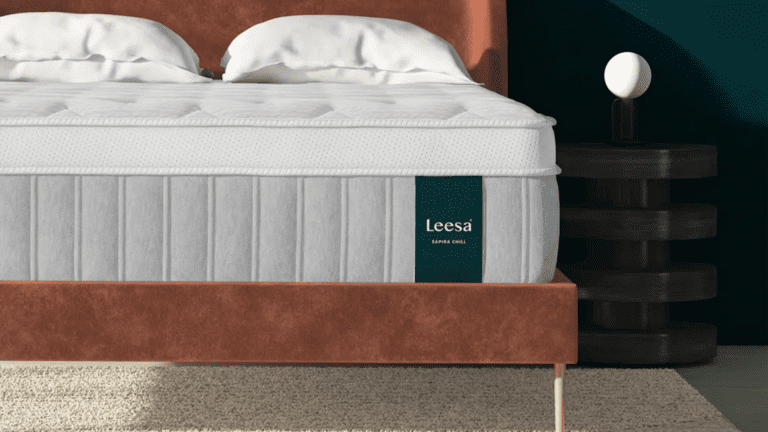
Best Mattress for Back Pain
WinkBed Plus
9.9 /10
Test Lab Score
30% off all WinkBeds mattresses
Shop at WinkBedsZoned latex and coils deliver targeted back support in this solidly built hybrid.
See More Details
Best Mattress for Side Sleepers
Nolah Evolution 15
9.2 /10
Test Lab Score
35% off sitewide + extra $100 off with code: SF100
Shop at NolahMulti-layer zoning engineered for long-term pressure relief at the hips and shoulders.
See More Details
Best Mattress for Heavy Sleepers
Titan Plus Core
8.4 /10
Test Lab Score
30% off sitewide
Shop at TitanHigh-density foams and robust coils engineered to support sleepers over 230 pounds without sagging.
See More Details
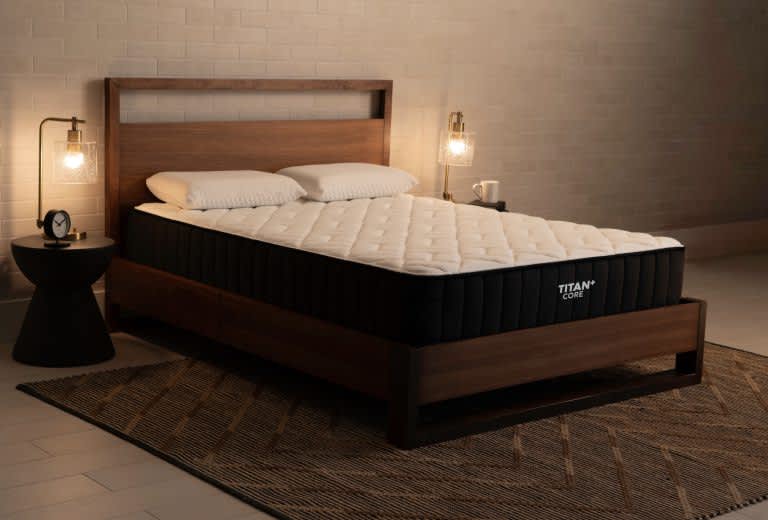
Best Mattress for Couples
Bear Elite Hybrid
8.5 /10
Test Lab Score
40% sitewide with code: SF40
Shop at BearContouring memory foam paired with zoned coils form a supportive and durable cradle.
See More Details
Best Temperature-Regulating Mattress
Birch Mattress
8.8 /10
Test Lab Score
25% off sitewide
Shop at BirchA sustainably made mattress that’s naturally breathable and durable.
See More Details
What Causes a Mattress to Sag?
Over time, foam breaks down and coils lose their ability to spring back to their original shape. Both of these issues can result in sagging. Most mattresses will sag eventually, but the quality of construction and materials can accelerate or delay the occurrence.
“A sagging mattress fails to provide uniform support to the spine and joints,” says Dr. Dustin Cotliar, M.D., MPH. “This inadequate support forces your body to maintain stressed positions during sleep, potentially contributing to aches and pains in the morning.”
Premature Sagging vs. Normal Wear and Tear
There are two primary components to a mattress: the comfort system and the support core. Ultimately, every layer of the mattress affects its propensity to sag. The comfort system is more prone to body indentations, whereas the support core can cause broader structural problems.
Support Core
The support core is usually made of sturdy materials such as steel springs or high-density polyfoam, which are designed to withstand repeated use before they start breaking down.
Mattresses with low coil counts or low-quality steel are quicker to lose their elasticity, and they generally sag sooner than higher-quality builds. A hybrid mattress made with low-quality coils may only last 5 to 6 years, whereas a better-quality base may lengthen the expected lifespan up to 8 or 10 years.
Likewise, low-density polyfoam with thinner cell walls and more air pockets is more susceptible to sagging. Lower quality all-foam models can break down as soon as 2 or 3 years after purchasing, whereas better models may last up to 7 or 8 years.
Comfort System
The comfort system tends to include softer materials such as memory foam, which can break down sooner and develop permanent indentations. Plus, mattresses with thicker comfort sections may be more vulnerable to forming body impressions. To a certain extent, this wear and tear is considered a normal part of mattress use. Sometimes, manufacturers add firmer transitional layers to reinforce the softer layers on top.
Check Your Warranty
Most manufacturers don’t cover sagging and body indentations under warranty unless they reach a certain level, such as 1-inch indentations that are visible even when no pressure is applied. If your mattress has body impressions that are not covered by the warranty and you find they affect the mattress’ ability to provide pressure relief, you may be able to compensate by using a mattress topper.
Although the warranty length and terms don’t always correspond to the quality of the mattress, these can be a good indication of how long the manufacturer expects the bed to last. Warranties that cover body impressions of at least 1 inch — as opposed to impressions of 1.5 or 2 inches — indicate that the construction will likely prevent premature sagging.
Similarly, longer warranties of 15 or 20 years imply that the mattress may last longer than average before needing to be replaced. These models are often more expensive up-front, but the price may be worthwhile if it saves you the cost of buying another new mattress within that time frame.
How to Choose a Durable Mattress
There are several indications that hint at when a mattress may start sagging, such as the price, the type of materials, and the firmness level. When purchasing a mattress, you should also consider factors that influence the overall comfort, such as temperature regulation and motion isolation, as well as whether the mattress design is appropriate for your body type and sleeping position.
Price
Mattress price is an easy way to weed out low-quality mattresses. While prices can vary according to brand, special features, or organic certifications, a cheap mattress will generally sag sooner. These beds may be suitable for guest rooms, but they likely aren’t designed to withstand regular use because to keep the price low, brands need to use lower quality materials.
Sleeping Position
Proper spinal support is important no matter what sleeping position you prefer. However, a sagging mattress may be most uncomfortable for stomach sleepers if it causes the midsection to sink in too much. Back sleepers also require an even, reliable surface to support the lower back.
Quality Materials
Mattresses built with natural materials such as latex and wool tend to outlast other materials. When assessing the quality of your mattress, note the coil count, the coil gauge or thickness, the foam density, and any vulnerable points that may be more susceptible to premature sagging, such as convoluted polyfoam. Look for manufacturers that are transparent with their specs.
Coil gauge refers to the thickness of the coils. Low-gauge (thicker) coils being more durable than high-gauge (thinner) coils, though high-gauge coils are also more responsive. While a higher coil count doesn’t necessarily correspond to a sturdier mattress, it’s a good idea to avoid counts lower than 400 for a queen mattress.
Firmness Level
The right firmness level for you depends on your body weight and primary sleep position. Broadly speaking, firmer mattresses tend to be more resistant to body impressions, although there are many exceptions as this also depends on the specific materials used. Stomach sleepers and individuals who weigh more than 230 pounds may find that a firm (7) or extra firm (9) mattress offers longer-lasting support.
Pressure Relief and Contouring
Pressure relief is a key factor for all sleepers, especially for side sleepers and those who weigh under 130 pounds. These sleepers can experience pressure points where the hips and shoulders make contact with the mattress, so they benefit from having cushioning materials in the comfort system. High-density memory foam, natural Talalay latex, and wool are examples of pressure-relieving materials with a long-expected lifespan.
Mattresses that contour more closely tend to provide better pressure relief, but they may be more apt to develop body impressions over time. Ideally, the comfort system should provide a certain level of contouring, while the transition layers and support core help bolster spinal support and enhance durability.
Edge Support
Whereas hybrid and innerspring models usually feature a reinforced perimeter, foam models may compress significantly when weight is placed on the edges of the bed. Weak edge support can significantly limit the usable surface area, so it’s an important consideration for people who like to sit on the edges, partners who share a smaller bed, or those who have trouble getting in and out of bed. Foam mattresses may break down sooner, so if you value edge support, consider a bed with a firmer, thinner comfort system.
What Mattress Type is the Most Durable?
The primary mattress types include hybrid, innerspring, foam, latex, and airbed. Mattress type is mainly determined by the materials used in the support core. While every model is unique, the mattress type plays a significant role in its performance and durability. Latex and hybrid mattresses often outperform foam and innerspring models when it comes to durability.
Hybrid
Hybrid mattresses combine a substantial comfort system with an innerspring core, which is typically made with pocketed coils to reduce noise and motion transfer. The comfort layers may incorporate polyfoam, memory foam, latex, wool, cotton batting, microcoils, or other pressure-relieving materials.
Hybrid mattresses offer better pressure relief than classic innerspring models, and they also tend to boast sturdy edge support and strong breathability due to the coil layer. This makes them ideal for hot sleepers and those who enjoy using the full surface of the bed.
When looking for a hybrid mattress that won’t sag, aim for a minimum of 400 coils in a queen size and dedicated reinforcement around the perimeter. In the comfort system, high-density foams or natural materials like wool or latex are usually the most durable.
Innerspring
Sleepers who favor bounce, edge support, and airflow may be interested in an innerspring model. This mattress type is made almost exclusively of tempered steel coils, with little to no comfort system. These features make innerspring mattresses suitable for stomach sleepers but less suitable for side and back sleepers.
The durability of an innerspring mattress can vary greatly depending on the type, the gauge, and the total number of coils. Thicker-gauge coils and designs such as offset coils can withstand more pressure without losing their resilience. By contrast, older designs such as Bonnell coils may start sagging sooner.
It’s good practice to ensure your mattress has an appropriate coil count for the type of coils used, though several other factors influence a mattress’ performance. Similarly, coils may have different functions depending on their gauge and placement in the mattress. Many manufacturers use thicker low-gauge coils to strengthen the edges and thinner high-gauge coils for flexibility around the hips and shoulders.
Foam
Foam mattresses contain polyfoam or memory foam, in the comfort system and sit above a polyfoam support core. Ideally, the support core uses durable high-density polyfoam with a density of at least 1.8 pounds per cubic foot (PCF).
Couples often prefer foam mattresses because the lack of springs allow less motion to transfer to the other side of the bed when one person moves. Models with memory foam in the comfort layers also offer unparalleled pressure relief for side sleepers and individuals under 130 pounds.
Sleepers over 230 pounds, however, may find that foam mattresses lack sufficient support. In addition to the foam density and quality of the materials used, the thickness of the comfort system can also affect a mattress’ lifespan. Thicker comfort systems are more likely to develop body impressions, especially if they are made with low-quality materials.
Latex
Natural latex is made from sap found in rubber trees, which is whipped into a froth and baked using either the Dunlop or the Talalay process. Dunlop latex tends to be denser on one side, whereas Talalay is more buoyant and uniform. Latex can also be made synthetically using petrochemicals.
Natural latex is considered one of the most durable mattress materials, making it highly resistant to sagging. It can be used in the comfort or support layers, and it is often aerated with pincore holes to improve breathability. Mattresses made with certified organic latex may be appealing to sustainably minded shoppers.
Airbed
Airbeds use air chambers as the support core, which can often be inflated or deflated by the user until they reach the desired firmness level. Provided there are no leaks in the air chambers, this system should be protective against sagging as more air can always be added to increase the firmness setting.
Sleepers who want adjustable firmness levels or couples with differing comfort preferences may be interested in an airbed, as each side of the bed generally includes its own customizable air chambers. Airbeds may have additional layers of polyfoam, memory foam, or other materials to supplement the air chambers as well.
Extending the Lifespan of Your Mattress
By adopting a few proactive habits, you can help keep your mattress in tip-top shape for a longer period of time and delay when you need to invest in a new one.
Use Proper Support Under The Mattress
A proper foundation is essential for keeping your mattress supported and preventing pressure points from improper spinal alignment. Consult the manufacturer’s website or the warranty terms to find out what type of base is recommended for your model. Generally, a solid or a slatted foundation will offer sufficient support. You may need to ensure the slats are close enough together to prevent sagging. A full mattress or larger may require additional support in the center of the bed.
Rotate Your Mattress
Most mattresses sold today aren’t designed to be flipped. However, you can delay the onset of permanent body impressions by rotating the mattress head-to-foot every 3 to 6 months.
Use a Mattress Protector and Clean Regularly
A mattress protector is a thin, waterproof membrane designed to protect your mattress against spills and stains. Not only does this help prevent accidental damage to your mattress, it can also prevent you from inadvertently voiding your mattress warranty, as most manufacturers won’t cover mattresses with visible stains.
How We Test: Your Comfort Is Our Science
Our industry-leading product testing team cares deeply about improving your sleep. Having a holistic understanding of a mattress’s role as part of a sleep system is paramount to our testing process. Since a bed’s comfort and feel depend largely on body weight and sleeping position, our testing team represents a wide range of body types, sleep positions, and comfort preferences.
In our Seattle-based Test Lab, we use an objective, hands-on process to evaluate mattresses across performance categories. The following are the key guidelines that inform our performance ratings. Our ultimate goal is to ensure you have all the information you need to make the best purchase decision for you.
Construction analysis: We begin testing each mattress by analyzing its design and making note firmness, height, individual layer composition, and sticker price. This allows us to evaluate qualities like support, durability, and value.
Product testing: Firsthand testing is crucial to our evaluation and ratings system. We use a wide range of tools and technology to test mattresses in six performance categories: motion isolation, pressure relief, temperature control, ease of movement, edge support, and odor potential.
Field testing: In addition to lab-based tests, we base our ratings on feedback from field testers who use the mattresses in their own homes. They spend several weeks collecting data — this gives us insights into how the mattress performs night after night for an extended period.
User testing: We curate feedback verified owners have provided in surveys, sleep stories, and product reviews. This helps us evaluate our initial findings and, if needed, tweak our ratings to reflect real-world experiences.
How We Determine Our Overall Scores


To determine a mattress’s overall score, we assign weighted percentages to performance categories based on how important they are to the individual sleep experience. For instance, areas like pressure relief and temperature control tend to matter more to people than something like off-gassing, and because more people sleep on their side and back than on their stomach, we weigh those positions more heavily.
Performance Categories
Motion Isolation
This criteria alludes to the amount of motion a mattress absorbs when a sleeper moves on the surface. We use two testers lying side by side to evaluate motion isolation, who each feel for transfer while the other person moves on the mattress.
Temperature Control
To determine how well a mattress regulates temperature, we perform temperature tests and look closely at its materials and construction. Many mattresses are designed with cooling components meant to reduce heat retention.
Pressure Relief
A bed with strong pressure relief excels at preventing pressure from building up in areas like the shoulders and hips. Beds with even contouring and weight distribution are top performers when it comes to pressure relief.
Off-Gassing
A mattress in a box may release unpleasant chemical odors for a short period after you’ve unboxed it. The initial smell may be strong but typically fades within 2 or 3 days.
Ease of Movement
This criteria reflects how easily a sleeper can move across a bed’s surface. Responsive surfaces made of latex typically perform better than foam surfaces, which can inhibit movement.
Edge Support
We perform sit tests along a bed’s perimeter to measure how well the edges push back against weight. Mattresses with strong edge support have minimal sagging when sleepers sit on or lie close to the perimeter.
Dive Deeper – Mattress Guides by Purpose
If you’re still concerned about finding the perfect mattress for your needs, take a look at our guides broken down by mattresses that help address specific issues.
Best Mattress by Specific Purpose
Frequently Asked Questions
What type of mattress is least likely to sag?
Latex mattresses are typically the most durable mattress type you can find. Hybrid mattresses, especially firmer models made with high-quality materials, also tend to resist sagging. Overall, look for natural, high-quality materials and a firmer feel to help ensure your mattress will last.
Will all mattresses sag eventually?
No mattress can last forever, so yes, every mattress will eventually begin to sag. However, some reach this point much faster than others. A thin, foam mattress made from cheaper materials may start sagging after only two or three years while a high-quality hybrid mattress can last eight to ten. To get the most out of your mattress, invest in one made from quality materials, make sure it’s well supported by your foundation, and rotate it every three to six months.
Can you reverse mattress sagging?
Unfortunately, you can’t fix a mattress once it’s started to sag. That’s usually the most obvious sign that your mattress needs to be replaced. You can use a thick, foam mattress topper to help even out the surface, but only as a temporary measure until you’re able to buy a new mattress.
How often should you replace your mattress?
Generally speaking, you should replace your mattress every six to eight years, but a lot depends on your specific mattress. A cheaper, foam mattress will likely break down sooner, while a high-end latex mattress can last longer.

Still have questions? Ask our community!
Join our Sleep Care Community — a trusted hub of product specialists, sleep health professionals, and people just like you. Whether you’re searching for the perfect mattress or need expert sleep advice, we’ve got you covered. Get personalized guidance from the experts who know sleep best.

